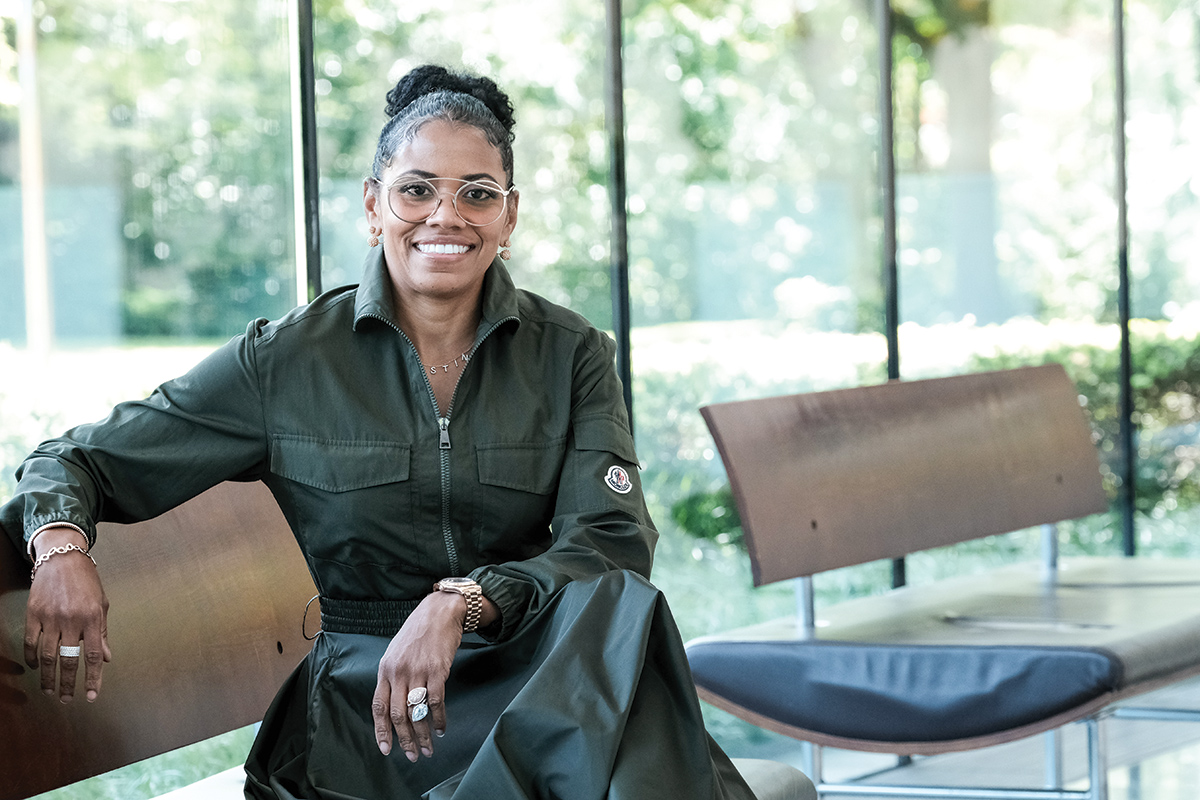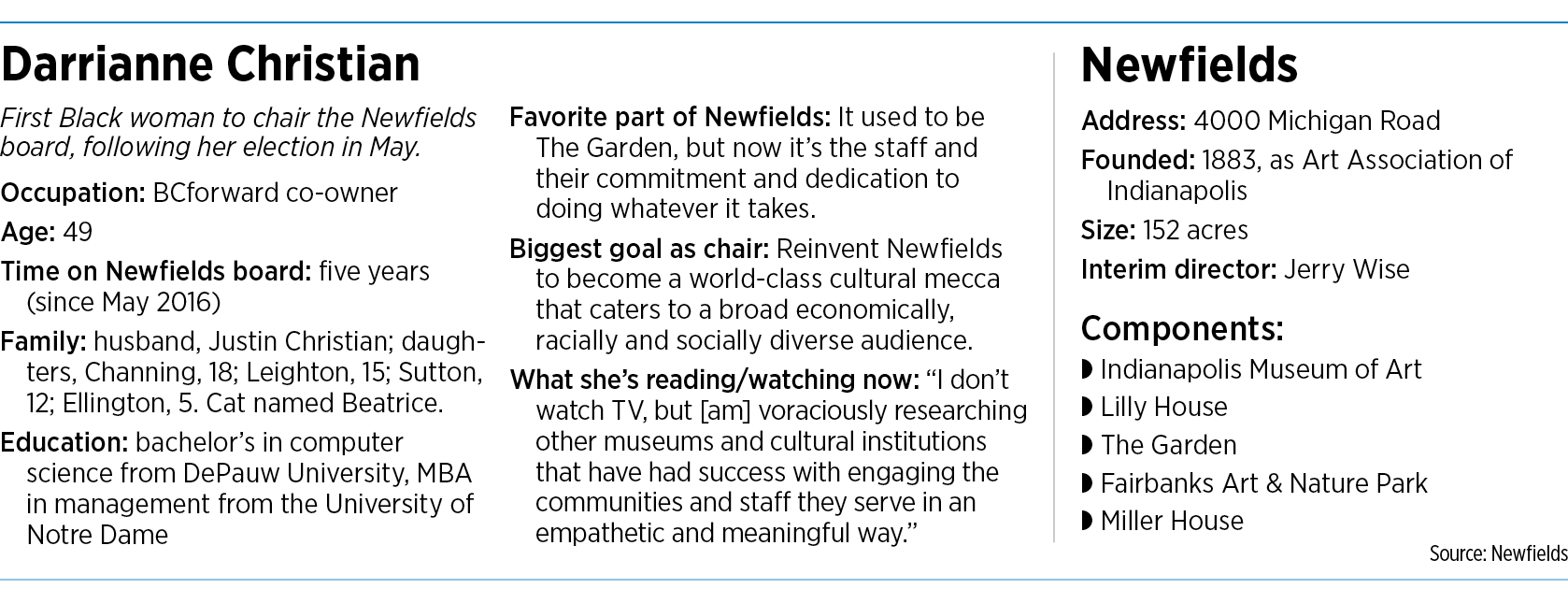Subscriber Benefit
As a subscriber you can listen to articles at work, in the car, or while you work out. Subscribe Now
Darrianne Christian in May became the first Black woman elected chair of the Newfields board of trustees, just months after the art museum and gardens faced an uproar over its handling of race and inclusion issues, a controversy that led its president to resign.
Christian joined the board in 2016 and was overseeing the marketing committee in 2017 when Newfields began considering ways to improve diversity for museum visitors.
Then, this February, when controversy erupted over a job posting that referenced the need to maintain “the museum’s traditional, core, white art audience,” Christian emerged as the board’s go-to leader on diversity.
She spoke with IBJ at length about the challenges the institution now faces as it struggles to rebuild its reputation and diversify its collections and its audience.
When you first heard about the controversy regarding the “core, white audience” reference, where were you and what was your response?
When it all unfolded, I was actually on vacation and completely unplugged. My first indication came when [our cruise ship] docked in Nassau so we could take a COVID test to reenter the U.S. As the boat came closer to land, my cell phone reception picked up and my phone just started going off with tons and tons of text messages and missed calls.
My first reaction was just disbelief, because that was not the Newfields that I’ve known.
I felt like I needed to err on the side of caution until I could understand what had truly happened. I sent emails to Charles Venable [then the Newfields president] and Katie Betley [then chairwoman] and I simply asked if it was real. I just didn’t believe that it had really happened.
After the eventual resignation of Venable, Newfields made some commitments to improve the diversity and representation on its board—as well as with the art it displays on its campus. What was your involvement in those conversations?
Katie Betley asked me to chair the committee that would provide the response to the community. Initially, the board said, “Hey, give us some time to kind of look at everything that’s going on and figure out what is going on here.”
Our first charge as a committee was to listen to the community, because we knew that damage had been done by the job posting, and we wanted to understand that damage. We also wanted to understand what we could do to make it better.
With the posting, we missed the mark, and we made a grave mistake with that. As a result, our first goal was just to get feedback about what we needed to do.
We’re now a few months past the situation and Newfields has released what you’ve referred to as a commitment plan, a pledge to take action. So what has Newfields done to remedy the problems?
I think what a lot of people aren’t aware of is that, when we did the commitment plan, a lot of the things that we put in that plan were things that we already had in place—[things] that Newfields was working on even when I came on as a trustee in 2016.
There was lots of talk at that time about being more diligent in our diversification efforts. So, we have started the process of diversity, equity, inclusion and access within the museum. A lot of the plan we implemented [included] things that we were doing internally, and it was just a matter of tweaking some things based on the feedback we received from the community.
How far off is Newfields from rebuilding the broken trust within the community, particularly among minorities and underrepresented groups?
We’re experiencing what overall America is experiencing, which is that we have a long way to go. There’s a lot that we must do to put ourselves in a position where we can rebuild trust within the community.
We have a very long way to go with this, in the same way [many other] institutions and organizations strive to be more diverse, equitable and inclusive, providing access to those who historically or traditionally have not had it.
I believe that we are going in the right direction, and the community has responded well to that. But we’re never going to rest on our laurels or have the position that we are doing everything that we should be doing. We are an institution that—going forward—will always challenge itself to ensure we are doing all we can do.
What is Newfields doing to bring those underrepresented communities into the fold of the Indianapolis arts scene and to boost the display of artwork that is more illustrative of the area’s diversity?
Several years ago, we came to the conclusion that our collection was lacking and not as diverse as it needed to be. We’re here on the corner of 38th and Dr. Martin Luther King [streets] and our representation of those in this immediate community was very sparse.
So, several years ago, we started the process of [selling] artwork in the museum to raise money specifically for the purpose of acquiring additional pieces by marginalized and underrepresented artists. Following the job posting, we knew we needed to continue that effort and put even more [conviction] behind it.
What about the exhibits that are at Newfields now or currently in the works? Were you able to make any changes to those to reflect these efforts?
As with most museums, our cycle for exhibits is about three to five years. With everything that we have going on from a diversity, equity and inclusion perspective, we know that we need to take a look at our exhibits and … to some extent, evaluate them through the lens of diversity and inclusion.
For some, that’s easy to do, and with others, it’s a bit more of a challenge. We just ask for the community’s patience with that.
For things like The Lume [an immersive digital art experience], announced last year, that’s a contract we have with another company. So, it’s very difficult for us to try to figure out how to take something like The Lume and figure out how to incorporate those components.
But for any exhibits that haven’t been fully planned yet, all of those things are definitely being evaluated so we have a much more stringent understanding of how diversity, equity and inclusion score before they go on display.
Newfields has been accused of racism. In your mind, is the problem directly related to racism or is it more about perceptions?
Personally, I don’t feel that Newfields has a racism problem. I think that America has a racism problem and Newfields is part of America. I do not think it’s fair to put that all on Newfields.
My experience here has never been like that. Of course, I’m coming from a position of power at the highest levels—I’m a trustee, so everyone knows to treat me a certain type of way.
By the same token, I think America is a country that has a lot of racism within it, and we’re having to reckon with that.
But the organization itself overall being a racist organization? Absolutely not. Everyone here was very heartbroken over the fact that we felt that we had damaged and caused harm to other people because of that job posting; no one felt good about the byproduct of that.
Some collaborators withdrew from projects with Newfields as a result of the situation. What has the institution done to repair that damage?
We have certainly tried to mend any relationships that we felt were damaged. And it’s our hope that, going forward, we will be able to work with all of those organizations that felt Newfields was a place that they couldn’t connect with as a result of the job posting.
We welcome the opportunity to work with those organizations. We’ve made it a point to apologize and to meet with them to do what we can to mend those relationships.
Are the apologies getting in the way of Newfields pursuing its mission, in your opinion?
I guess it depends on who you are, but I don’t see where apologizing could ever be perceived as a negative. If you make a mistake, you have to own it.
We’re not going to run away from what happened. We’re going to own it and make the change.
We want to be a place for the community, and if there’s anyone in the community who feels hurt by what we did, we’re going to apologize for that. It costs us nothing to say, “I’m sorry.”
What are you most looking forward to in your role as chair of the board?
I’m really looking forward to working with the board and the staff, getting a new CEO, and really implementing the new direction that we’re trying to take.
While we have our struggles and issues we’re trying to work through, I also feel like we have a new place. The museum’s leadership is reinvigorated—they’re looking forward to us starting the search and bringing in a new CEO and just moving the organization in a different direction.
I think staff is excited about the fact that they now have the [ear] of the board and senior leadership, because we are engaging with them for more feedback on projects, like an ongoing external review assessment, which is doing a cultural audit.
My goal is that Newfields becomes a cultural institution that other cultural institutions can look to and say, “Hey, they got it right—they figured out how to connect with the community, how to engage with everyone and meet them where they were, in a positive and meaningful way.”
What’s the biggest challenge Newfields now faces?
I think the biggest challenge is that we’ve historically been an organization that has to cater to a very small audience. So we must figure out how to cater to a much broader audience in a way that is meaningful, engaging and sustainable long term.
In the conversations that we are having, ultimately, our goal is to have an audience that is connected, engaged, and sees and feels part of the Newfields community. And, for the long term, they see us as a place to come to for enjoyment, engagement, connection and inspiration.•
Please enable JavaScript to view this content.


“…I think America is a country that has a lot of racism within it, and we’re having to reckon with that.”
If this statement is true, I’d like for Mrs. Christian to start by analyzing her own racist thoughts, attitudes, and behaviors.
Unfortunately, what America is actually grappling with is a loud and pretentious cohort of individuals who profit from hyperbolically exaggerating and instigating class and racial warfare. Where Newfields should be a respite from this chaos, it instead embraces a psychotic worldview and will focus on pushing away normal, everyday Americans. I suppose that is OK to the deluded leadership since these patrons are perceived as mostly racist, anyway. At least only inclusive and diverse people will remain as its patrons — yes? Whatever today’s definitions of those words might be.